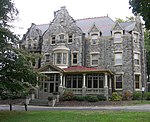Ridge Avenue Bridge in Philadelphia
Bridges completed in 1888Bridges in PhiladelphiaBridges on the National Register of Historic Places in PhiladelphiaNorthwest PhiladelphiaPennsylvania bridge (structure) stubs ... and 3 more
Philadelphia County, Pennsylvania Registered Historic Place stubsRoad bridges on the National Register of Historic Places in PennsylvaniaStone arch bridges in the United States

The Ridge Avenue Bridge in Philadelphia is a historic bridge in Philadelphia, Pennsylvania. A triple-span stone arch bridge built in 1888, it carries Ridge Avenue over the Wissahickon Creek. It is the last crossing of the creek before it empties into the Schuylkill River. Four other stone arch bridges cross the Wissahickon. The 119.1-ft-long bridge was rehabilitated in 1954. The bridge was added to the National Register of Historic Places in 1988.
Excerpt from the Wikipedia article Ridge Avenue Bridge in Philadelphia (License: CC BY-SA 3.0, Authors, Images).Ridge Avenue Bridge in Philadelphia
Ridge Avenue, Philadelphia
Geographical coordinates (GPS) Address Nearby Places Show on map
Geographical coordinates (GPS)
| Latitude | Longitude |
|---|---|
| N 40.014722222222 ° | E -75.207222222222 ° |
Address
Wissahickon Transportation Center
Ridge Avenue
19127 Philadelphia
Pennsylvania, United States
Open on Google Maps








